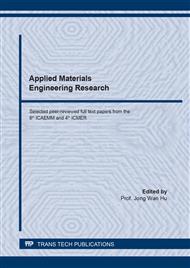[1]
Agarwa, R, Chandrasekaran, S, Sridhar, M, 2016. Imagining construction's digital future, Singapore: McKinsey Productivity Sciences Center.
Google Scholar
[2]
Ayodeji E. Oke, C. O. A. K. S., 2017. Energy Savings and Sustainable Construction: Examining the Advantages of Nanotechnology. Elsevier, 142(1), pp.3839-3843.
DOI: 10.1016/j.egypro.2017.12.285
Google Scholar
[3]
Beverly Chiang, n.d. pbctoday. [Online] Available at: https://www.pbctoday.co.uk/news/planning-construction-news/technological-changes-construction-industry/48531/ [Accessed 28 April 2020].
Google Scholar
[4]
Bharathidasan.D., & Muhibullah.J. (2017). Solar Cells and Nanotechnology. IOSR Journal of Electrical and Electronics Engineering, I(1), 08-11.
Google Scholar
[5]
Broekhuizen F.A., & Broekhuizen J.C. (2009). Nanotechnology in the European Construction Industry-State of the Art Executive Summary. European Federation of Building Woodworkers (p.29). Amsterdam, Netherlands: IVAM UvA BV.
Google Scholar
[6]
Critchley.L. (2018). AzoNano. Retrieved from https://www.azonano.com/article.aspx?ArticleID=5007.
Google Scholar
[7]
Heerden, L. v., 2019. The JourneyApps Blog. [Online] Available at: https://journeyapps.com/blog/which-industries-most-digital-why/.
Google Scholar
[8]
Kanagalakshmi A.S., Arivukarasi M.C., Keerthana C.M., Subashri.R., & Priya V.V. (2019). Nano Technology in Construction. Journal of Mechanical and Civil Engineering, 15(1), 53-56.
Google Scholar
[9]
Khitab.A., & Arshad M.T. (2014). Nano Constrcution Materials: Review. Advanced Study Center Co. Ltd, 181-189.
Google Scholar
[10]
Mohajerani.A., Burnett.L., Smith J.V., Kurmus.H., Milas.J., Arulrajah.A., . . . Kadir A.A. (2019). Nanoparticles in Constrcution Materials and Other Applications, and Implications of Nanoparticle Use. MDPI, 12(3052), 1-25.
DOI: 10.3390/ma12193052
Google Scholar
[11]
Monica J. Hanus, A. T. H., 2012. Nanotechnology Innovations for the Construction. Elsevier, 58(1), pp.1056-1102.
Google Scholar
[12]
Nandekar.U.P, & Rautdesai.R. (2019). Nanotechnology Innvovations in Construction Industry and Environmental Sustainability. International Journal of Innovative Technology and Exploring Engineering, 8(11S), 286-291.
DOI: 10.35940/ijitee.k1055.09811s19
Google Scholar
[13]
Samal S.S., & Manohara S.R. (2019). Nanoscience and Nanotechnology in Inida: A Broad Perspective. Science Direct, 151-158.
Google Scholar
[14]
Saurav.S. (2012). Application of Nanotechnology in Building Materials. International Journal of Engineering Research and Applications, 2(5), 1077-1082.
Google Scholar
[15]
Sharma.V.P, Sharma.U, Chattopadhyay.M & Shukla.V.N, 2018. Advance Applications of Nanomaterials: A Review. ScienceDirect, Issue 5, pp.6376-6380.
DOI: 10.1016/j.matpr.2017.12.248
Google Scholar


